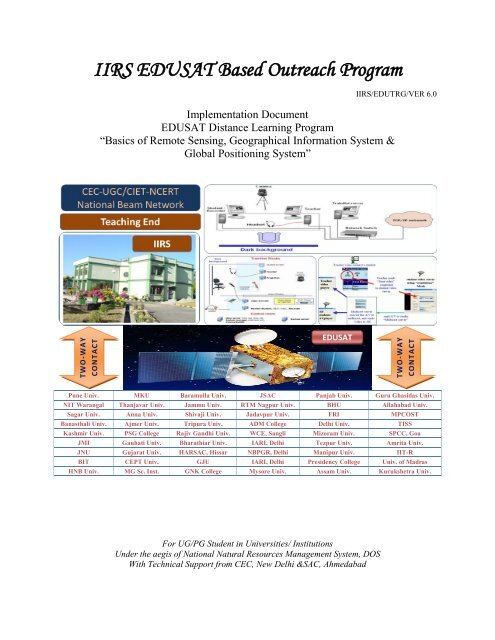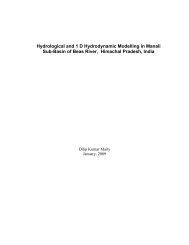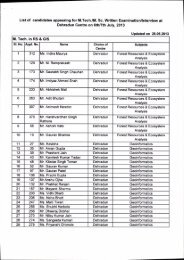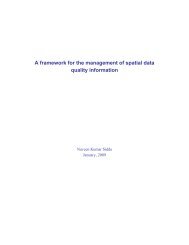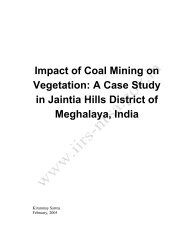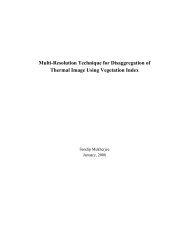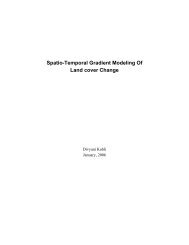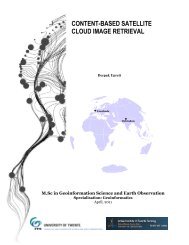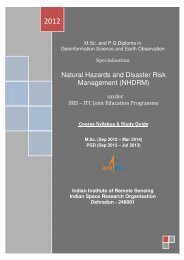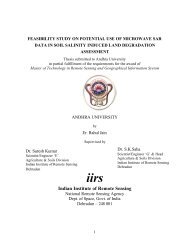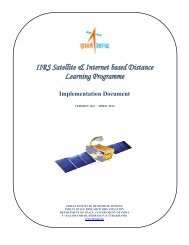IIRS EDUSAT Based Outreach Program - Indian Institute of Remote ...
IIRS EDUSAT Based Outreach Program - Indian Institute of Remote ...
IIRS EDUSAT Based Outreach Program - Indian Institute of Remote ...
Create successful ePaper yourself
Turn your PDF publications into a flip-book with our unique Google optimized e-Paper software.
TWO-WAY<br />
CONTACT<br />
TWO-WAY<br />
CONTACT<br />
<strong>IIRS</strong> <strong>EDUSAT</strong> <strong>Based</strong> <strong>Outreach</strong> <strong>Program</strong><br />
<strong>IIRS</strong>/EDUTRG/VER 6.0<br />
Implementation Document<br />
<strong>EDUSAT</strong> Distance Learning <strong>Program</strong><br />
―Basics <strong>of</strong> <strong>Remote</strong> Sensing, Geographical Information System &<br />
Global Positioning System‖<br />
<strong>EDUSAT</strong><br />
Pune Univ. MKU Baramulla Univ. JSAC Panjab Univ. Guru Ghasidas Univ.<br />
NIT Warangal Thanjavar Univ. Jammu Univ. RTM Nagpur Univ. BHU Allahabad Univ.<br />
Sagar Univ. Anna Univ. Shivaji Univ. Jadavpur Univ. FRI MPCOST<br />
Banasthali Univ. Ajmer Univ. Tripura Univ. ADM College Delhi Univ. TISS<br />
Kashmir Univ. PSG College Rajiv Gandhi Univ. WCE, Sangli Mizoram Univ. SPCC, Goa<br />
JMI Gauhati Univ. Bharathiar Univ. IARI, Delhi Tezpur Univ. Amrita Univ.<br />
JNU Gujarat Univ. HARSAC, Hissar NBPGR, Delhi Manipur Univ. IIT-R<br />
BIT CEPT Univ. GJU IARI, Delhi Presidency College Univ. <strong>of</strong> Madras<br />
HNB Univ. MG Sc. Inst. GNK College Mysore Univ. Assam Univ. Kurukshetra Univ.<br />
For UG/PG Student in Universities/ Institutions<br />
Under the aegis <strong>of</strong> National Natural Resources Management System, DOS<br />
With Technical Support from CEC, New Delhi &SAC, Ahmedabad
This compilation © 2011 is funded by the <strong>Indian</strong> <strong>Institute</strong> <strong>of</strong> <strong>Remote</strong> Sensing (<strong>IIRS</strong>) <strong>Outreach</strong><br />
<strong>Program</strong>. Reproduction <strong>of</strong> this volume or any parts there<strong>of</strong> (excluding short quotations for the<br />
use in the preparation <strong>of</strong> reviews and technical and scientific papers) may be made only after<br />
obtaining the specific approval <strong>of</strong> the publisher. The facts appearing in this volume are only<br />
indicative. Authors retain all rights to the content.<br />
Version<br />
6.0 – 4 July 2011<br />
Editors<br />
PLN Raju (raju@iirs.gov.in)<br />
Prasun Kumar Gupta (prasun@iirs.gov.in)<br />
Geoinformatics Division<br />
<strong>Indian</strong> <strong>Institute</strong> <strong>of</strong> <strong>Remote</strong> Sensing<br />
<strong>Indian</strong> Space Research Organisation<br />
Published by<br />
<strong>EDUSAT</strong> Team<br />
<strong>Indian</strong> <strong>Institute</strong> <strong>of</strong> <strong>Remote</strong> Sensing<br />
<strong>EDUSAT</strong> Studio & Control Room 2007-2011<br />
<strong>Indian</strong> <strong>Institute</strong> <strong>of</strong> <strong>Remote</strong> Sensing<br />
<strong>Indian</strong> Space Research Organisation<br />
Dept. <strong>of</strong> Space, Govt. <strong>of</strong> India<br />
#4 Kalidas Road, Dehradun<br />
Uttarakhand 248001, India<br />
Tel: +91 135 252 4130<br />
Fax: +91 135 274 1987<br />
e-mail: edusat@iirs.gov.in<br />
<strong>IIRS</strong> WEB Homepage: http://www.iirs.gov.in
Table <strong>of</strong> Contents<br />
1. About <strong>Indian</strong> <strong>Institute</strong> <strong>of</strong> <strong>Remote</strong> Sensing ............................................................................................ 1<br />
2. About <strong>EDUSAT</strong> ....................................................................................................................................... 2<br />
3. <strong>EDUSAT</strong> Network .................................................................................................................................. 3<br />
4. Why <strong>EDUSAT</strong> based training? ............................................................................................................... 4<br />
5. Utilization <strong>of</strong> <strong>EDUSAT</strong> bandwidth by <strong>IIRS</strong> .............................................................................................. 5<br />
6. Course Overview ................................................................................................................................... 7<br />
7. CEC-UGC role in implementation <strong>of</strong> the program .............................................................................. 11<br />
8. Initial Setup ......................................................................................................................................... 11<br />
9. Online Learning Management System “TrainNet” ............................................................................. 12<br />
10. Future Plan ...................................................................................................................................... 13<br />
11. List <strong>of</strong> <strong>IIRS</strong> Faculty members involved (2007 – 2011) ..................................................................... 13<br />
12. List <strong>of</strong> Guest Faculty members involved in <strong>EDUSAT</strong> Course (2007-2011) ..................................... 20<br />
13. List <strong>of</strong> Participated Universities (2007 – 11) ................................................................................... 21<br />
14. Feedback from the Universities ...................................................................................................... 26<br />
15. Annexure 1: Total Number <strong>of</strong> Participants in <strong>EDUSAT</strong> Course (Till 2010) ...................................... 29<br />
16. Annexure 2: Abbreviations ............................................................................................................. 32
Table <strong>of</strong> Figures and Tables<br />
Figure 1 - Development & Launch <strong>of</strong> <strong>EDUSAT</strong> .............................................................................................. 2<br />
Figure 2 - Regional Beams & National Beam ................................................................................................ 2<br />
Figure 3 : Potential Uses <strong>of</strong> <strong>EDUSAT</strong> ............................................................................................................. 3<br />
Figure 4 : Total Number <strong>of</strong> Participants in 5 years ....................................................................................... 5<br />
Table 1 : <strong>IIRS</strong> - <strong>EDUSAT</strong> Summary <strong>of</strong> Courses till 2011 .................................................................................. 6<br />
Table 2: <strong>IIRS</strong> <strong>EDUSAT</strong> Course Curriculum ...................................................................................................... 7<br />
Table 3: <strong>EDUSAT</strong> Advance Course Curriculum .............................................................................................. 8<br />
Table 4: List <strong>of</strong> Faculty <strong>of</strong> <strong>EDUSAT</strong> Basic Course ......................................................................................... 13<br />
Table 5: List <strong>of</strong> Guest Faculty <strong>of</strong> <strong>EDUSAT</strong> Course ........................................................................................ 20<br />
Table 6: Participant Universities ................................................................................................................. 21<br />
Table 7: Total Number <strong>of</strong> <strong>EDUSAT</strong> Course Participants .............................................................................. 29<br />
Table 8: Abbreviations ................................................................................................................................ 32
<strong>EDUSAT</strong> Distance Learning <strong>Program</strong><br />
Basics <strong>of</strong> <strong>Remote</strong> Sensing, Geographical Information<br />
System & Global Positioning System<br />
1. About <strong>Indian</strong> <strong>Institute</strong> <strong>of</strong> <strong>Remote</strong> Sensing<br />
<strong>Indian</strong> <strong>Institute</strong> <strong>of</strong> <strong>Remote</strong> Sensing (<strong>Indian</strong> Space Research Organization, Department <strong>of</strong> Space,<br />
Government <strong>of</strong> India) is a premier training and education institute dealing with <strong>Remote</strong> Sensing,<br />
Geoinformation Science & GPS Technology and their Applications. Since April 30, 2011<strong>IIRS</strong><br />
has become a unit <strong>of</strong> ISRO. <strong>IIRS</strong> endeavor has been to train thematic experts from user<br />
community including academic institutions in <strong>Remote</strong> Sensing(RS) & Geographical Information<br />
System(GIS) technology/applications at Post Graduate level with the overall goal <strong>of</strong> ‗technology<br />
transfer‘ and user awareness. The <strong>Institute</strong> has evolved many programs which are tuned to the<br />
different needs <strong>of</strong> various target groups.<br />
<strong>IIRS</strong> conducts a variety <strong>of</strong> courses for the different categories <strong>of</strong> users including fresh<br />
postgraduate students viz., M. Tech., M.Sc., PG Diploma Courses, 4 months Certificate Courses,<br />
2 months NNRMS sponsored courses for University Faculty, 2 weeks on demand Special<br />
Courses and 1 week duration Overview Course for Decision Makers.<br />
<strong>IIRS</strong> has trained more than 7800 scientists/engineers including 725 foreign students from various<br />
countries <strong>of</strong> Asia and Africa. The participants from African nations have also benefited under<br />
SHARES Fellowship <strong>Program</strong> <strong>of</strong> the Department <strong>of</strong> Space, ITEC/SCAAP Fellowship Scheme <strong>of</strong><br />
the Ministry <strong>of</strong> External Affairs, Government <strong>of</strong> India, and other Fellowship Schemes etc. In<br />
addition, <strong>IIRS</strong> houses state <strong>of</strong> the art infrastructure facilities for both RS and GIS. It has<br />
experienced and internationally known teaching faculty with specialization in RS & GIS<br />
Technology and its applications. <strong>IIRS</strong> is the host institute as well as, headquarters for the Centre<br />
for Space Science and Technology Education for Asia and Pacific (CSSTE-AP) region under<br />
United Nations. It is first <strong>of</strong> its kind established in the region and conducts regular postgraduate<br />
and short courses in <strong>Remote</strong> Sensing and GIS every year since 1996.<br />
It should be noted that, <strong>IIRS</strong> has been recognized by National Natural Resources Management<br />
System (NNRMS) to conduct specialized courses for the duration <strong>of</strong> 8 weeks every year for<br />
University faculty at Postgraduate level so that they are able to impart education on specific<br />
subjects on <strong>Remote</strong> Sensing and GIS in their area <strong>of</strong> specialization and/or start new programs<br />
like M. Tech/ M. Sc/ Postgraduate diploma with emphasis on RS & GIS application in their<br />
institutions. <strong>IIRS</strong> has trained more than 575 University faculty spread all over India. Many<br />
universities have been benefited from the <strong>IIRS</strong> training programs and have started RS & GIS<br />
courses at postgraduate level with institutional support from <strong>IIRS</strong>.<br />
1
2. About <strong>EDUSAT</strong><br />
<strong>EDUSAT</strong> is the first <strong>Indian</strong> satellite built<br />
exclusively for serving the educational sector and<br />
was launched successfully by GSLV-F01 on 20-<br />
9-2004 (Figure 1: Development & Launch <strong>of</strong><br />
<strong>EDUSAT</strong>). It is mainly intended to meet the<br />
demand for an interactive satellite based distance<br />
education system for the country. It strongly<br />
reflects India‘s commitment to use space<br />
technology for national development, especially<br />
for the development <strong>of</strong> the population in remote<br />
and rural locations. The 1950 kg <strong>EDUSAT</strong> was<br />
launched from Satish Dhawan Space Centre<br />
(SDSC) SHAR, Sriharikota, into a<br />
Geosynchronous Transfer Orbit (GTO) by<br />
ISRO‘s Geosynchronous Satellite Launch<br />
Vehicle (GSLV).<br />
Figure 1 - Development & Launch <strong>of</strong> <strong>EDUSAT</strong><br />
The satellite is co-located with KALPANA-1<br />
and INSAT-3C satellites at 74 deg East<br />
longitude. Compared to the satellites launched in<br />
the INSAT series so far, <strong>EDUSAT</strong> has several<br />
new technologies. The spacecraft is built around<br />
a standardized spacecraft bus called I-2K. It has<br />
a multiple spot beam antenna with 1.2 m<br />
reflector to direct the Ku band spot beams<br />
precisely towards their intended regions <strong>of</strong><br />
India, a dual core bent heat pipe for thermal<br />
control, high efficiency multi-junction solar<br />
cells and an improved thruster configuration for<br />
optimized propellant use for orbit and<br />
Figure 2 - Regional Beams & National Beam orientation maintenance. The satellite uses<br />
radiatively cooled Ku band Traveling Wave<br />
Tube Amplifiers (TWTAs) and dielectrically loaded C-band Demultiplexer for its<br />
communication payloads. <strong>EDUSAT</strong> carries five Ku-band transponders providing spot beams,<br />
one Ku-band transponder providing a national beam and six Extended C-band transponders with<br />
national coverage beam (Figure 2: Regional Beams & National Beams). (http://www.isro.gov.in)<br />
The 5 th & 6 th courses conducted by <strong>IIRS</strong> were using the INSAT 4CR satellite.<br />
2
3. <strong>EDUSAT</strong> Network<br />
In the first phase <strong>of</strong> pilot projects, a Ku-band<br />
transponder on-board INSAT-3B, already in orbit, was<br />
used. In this phase, Visveswaraiah Technological<br />
University (VTU) in Karnataka, Y B Chavan State<br />
Open University in Maharashtra and Rajiv Gandhi<br />
Technical University in Madhya Pradesh were<br />
covered. In the second phase, <strong>EDUSAT</strong> is being used<br />
in a semi-operational mode and at least one uplink in<br />
each <strong>of</strong> the five spot beams will be commissioned.<br />
About 100-200 classrooms will be connected in each<br />
beam. Coverage will be extended to the whole <strong>of</strong> India Figure 3 : Potential Uses <strong>of</strong> <strong>EDUSAT</strong><br />
through spot beams and the Ku-band national beam<br />
will also be used to connect a few national institutions. The Hub for National Beam has been<br />
established at Ahmedabad.<br />
The National Beam is planned to be used for:<br />
Indira Gandhi National Open University —100 terminals across the country and another<br />
20 terminals in the North East for teachers‘ training.<br />
National Council for Educational Research and Training — 100 terminals for Secondary<br />
and Higher Secondary Education and Teachers Training.<br />
<strong>Indian</strong> <strong>Institute</strong>s <strong>of</strong> Technology at Kharagpur and Chennai — 70 and 5 terminals<br />
respectively<br />
<strong>Institute</strong> <strong>of</strong> Electronics and Tele-communication Engineers — 18<br />
DST/National Council <strong>of</strong> Science Museums — 25<br />
Centre for Environmental Education — 5<br />
Regional Beams <strong>of</strong> <strong>EDUSAT</strong> were planned to be as follows:<br />
Southern Beam: Anna University, Chennai (260 nodes), Annamalai University, Chennai<br />
(57 nodes), Gandhigram Rural <strong>Institute</strong>, Dindigal(90 nodes), Bharathidasan University,<br />
Tiruchirapalli (22 nodes),Sarva Shiksha Abhiyan, Tamilnadu (442 nodes)<br />
Western Beam: Gujarat Government, Department <strong>of</strong> Education (148 nodes), Maharashtra<br />
Knowledge Corporation Ltd (50 nodes), July 2005 Depar tment <strong>of</strong> Higher Education, MP<br />
(50 nodes), Tribal Development, MP (50 nodes), BITS, Pilani (20 nodes), Technical<br />
Education Board, Rajasthan (91 nodes) and Blind People‘s Association, Ahmedabad (25<br />
nodes)<br />
Northern Beam: State <strong>Institute</strong> <strong>of</strong> Educational Technology (67 nodes), Guru Nanak Dev<br />
3
University (GNDU), Amritsar (40 nodes), Tapar <strong>Institute</strong> <strong>of</strong> Engineering and<br />
Technology, Patiala 10 nodes), Department <strong>of</strong> Training and Technical Education,New<br />
Delhi (40 nodes), UP Rajashri Tandon Open University, Allahabad (55 nodes)<br />
Eastern Beam: West Bengal University <strong>of</strong> Technology, Kolkata (40 nodes), Vidyasagar<br />
University, Midnapore, West Bengal (10 nodes), Netaji Subhas Open University, Kolkata<br />
(90 nodes), Jarkhand Education Project Council, Ranchi (192 nodes)<br />
North-Eastern Beam: Assam Agricultural University, Jorhat (18 nodes), Arunachal<br />
University, Itanagar (13 nodes), Manipur University, Imphal (200 nodes), Nagaland<br />
University, Kohima (10 nodes), Sikkim Government Law College, Gangtok (20 nodes)<br />
The <strong>IIRS</strong> <strong>EDUSAT</strong> based program is broadcast on the National beam covering all<br />
universities within the geographical bounds <strong>of</strong> <strong>Indian</strong> sub continent.<br />
4. Why <strong>EDUSAT</strong> based training?<br />
Contact based training though advantageous and beneficial, is not always possible for many to<br />
attend due to time limitations, financial constraints and importantly day-to-day commitments at<br />
work place. There are many types <strong>of</strong> training courses, which can be attended from a distance<br />
with different types <strong>of</strong> technology and tools. The first among them is the distance education<br />
(correspondence courses) supported either with or without study centers. The next one is<br />
―Internet based courses‖ replacing the conventional correspondence courses. The advanced type<br />
<strong>of</strong> courses are ―e-learning‖ where the student can avail the content <strong>of</strong> the course through the<br />
internet, stream the lectures using the internet and have interaction with teachers on a specified<br />
date. They can be provided with FAQs (Frequently Asked Questions) and quiz materials for easy<br />
learning. The students can appear for examinations on a specified date and location.<br />
The <strong>EDUSAT</strong> based training also follows more or less e-learning method and provides direct<br />
interaction with the teacher/expert when the lecture is delivered using <strong>EDUSAT</strong> satellite<br />
communication. It is advantageous because <strong>of</strong> its good quality reception and interactions are not<br />
constrained due to bandwidth problems <strong>of</strong> Internet.<br />
4
5. Utilization <strong>of</strong> <strong>EDUSAT</strong> bandwidth by <strong>IIRS</strong><br />
The use <strong>of</strong> <strong>Remote</strong> Sensing (RS), Geographic Information System (GIS), Global Positioning<br />
System (GPS) and associated geo-spatial technologies is increasing rapidly, creating an urgent<br />
demand for trained manpower. <strong>IIRS</strong> proposes to utilize the <strong>EDUSAT</strong> facility to strengthen<br />
institutions by sharing <strong>IIRS</strong> faculty expertise in running Geoinformatics programs, train students<br />
at undergraduate / postgraduate level at institutions that have established Geoinformatics facility<br />
with the funding support from NNRMS and other institutions/organizations that regularly<br />
approach <strong>IIRS</strong> for Geoinformatics expertise.<br />
Under the <strong>EDUSAT</strong> training program,<br />
<strong>IIRS</strong> has established its own Teaching<br />
end Studio and Uplinking facility in<br />
the campus under national beam<br />
coverage <strong>of</strong> <strong>EDUSAT</strong> and link with<br />
the users. The First training course<br />
was conducted for 12<br />
universities/institutions on ―Basics <strong>of</strong><br />
<strong>Remote</strong> Sensing, Geographical<br />
Information System and Global<br />
Positioning System‖ for 6 weeks<br />
duration during January 29 – 09 April<br />
2007 with participation <strong>of</strong> 349 students Figure 4 : Total Number <strong>of</strong> Participants in 5 years<br />
registered for this course. In the<br />
second course the number <strong>of</strong> universities rose to 22. It was conducted during September 19 –<br />
December 3, 2007 and 931 participants benefitted from the course over the years 2008, 2009 and<br />
2010, 3 more courses were conducted with participation <strong>of</strong> around 4000 students from 50 <strong>Indian</strong><br />
Universities as indicated in Table 1and Figure 4.<br />
Viewing the increasing demand for specialized courses, a 6 th <strong>EDUSAT</strong> based course on<br />
―Advances in Geoinformatics‖ was organized from 14 th Feb to 9 th March, 2011 in which 13<br />
universities participated.<br />
5
Table 1 : <strong>IIRS</strong> - <strong>EDUSAT</strong> Summary <strong>of</strong> Courses till 2011<br />
<strong>EDUSAT</strong> Course Summary<br />
First Course<br />
Second<br />
Course<br />
Third<br />
Course<br />
Fourth<br />
Course<br />
Fifth Course Sixth Course Total<br />
No. <strong>of</strong> Lecture Hrs. 45 34 36 35.3 41.1 10 201.4<br />
Hrs. <strong>of</strong> Interactive<br />
Session<br />
15 17.5 18 12 10.2 3 75.7<br />
Total Hrs 60 51.5 54 47.3 51.3 13 277.1<br />
Total No. <strong>of</strong><br />
Participants<br />
Total Universities<br />
Participated<br />
Total Universities<br />
Interacted<br />
349 931 915 931 982 179 4287<br />
12 22 40 48 26 10 55<br />
9 18 25 20 13 6<br />
Course Duration<br />
29Jan07-<br />
9Apr07<br />
19Sep07-<br />
03Dec07<br />
25Aug08-<br />
20Nov08<br />
12Aug09-<br />
30Oct09<br />
4Oct10-<br />
9Dec10<br />
14Feb11-<br />
9Mar11<br />
6
6. Course Overview<br />
Course Structure and Curriculum<br />
The training course on ―<strong>Remote</strong> Sensing, Geographical Information System and Global<br />
Positioning System‖ for university students is structured into four modules as detailed below:<br />
Module 1 <strong>Remote</strong> Sensing & Digital Image Processing 2 Weeks<br />
Module 2 Global Positioning System 1 Week<br />
Module 3 Geographical Information Systems 2 Weeks<br />
Module 4 Applications and advances 1 Week<br />
Total 6 Weeks<br />
The details <strong>of</strong> course curriculum for basic course for each topic is given in the following table:<br />
Table 2: <strong>IIRS</strong> <strong>EDUSAT</strong> Course Curriculum<br />
S.No. Course Curriculum Duration<br />
1<br />
<strong>Remote</strong> sensing<br />
Principles <strong>of</strong> <strong>Remote</strong> Sensing<br />
Platforms and sensors<br />
Thermal <strong>Remote</strong> Sensing<br />
Microwave <strong>Remote</strong> Sensing<br />
Spectral Signature properties <strong>of</strong> Soil, Water and<br />
Vegetation<br />
Atmospheric interactions <strong>of</strong> EMR<br />
Elements <strong>of</strong> Interpretation<br />
<strong>Indian</strong> <strong>Remote</strong> Sensing Satellite programs<br />
Satellite data reception, products generation and ordering<br />
procedures<br />
Digital image analysis<br />
Pre-processing, enhancement techniques and<br />
Classification<br />
algorithms(Supervised and Unsupervised)<br />
2<br />
Global Positioning System<br />
Overview <strong>of</strong> GPS/other Navigation System Signals,<br />
constellation and<br />
functionality<br />
Navigation Principles, code and carrier wave<br />
measurements<br />
GPS Errors<br />
Principles <strong>of</strong> Differential GPS<br />
Surveying Methods and integration with GIS themes<br />
Application case studies<br />
Comparison <strong>of</strong> different navigation systems<br />
2 Weeks<br />
Total 21 hrs<br />
Lectures – 9 hrs;<br />
Interaction / Discussion –<br />
8 hrs i.e., 30 minutes each<br />
after one hour lecture<br />
Demonstration / hands<br />
on – 4 hrs, i.e. 30 min<br />
each after one hour<br />
practical demonstration<br />
and discussion<br />
1 Week<br />
Total 6 hrs<br />
Lectures – 2 hrs;<br />
Interaction /<br />
Discussion – 2 hr i.e. 30<br />
Minute each after one<br />
hour lecture<br />
Demonstration / hands<br />
on - 2 hr, i.e. 30 Minute<br />
each after one hour l<br />
demonstration and<br />
discussion<br />
7
3<br />
4<br />
Geographical Information System<br />
Overview <strong>of</strong> GIS<br />
Spatial Data Models (Vector and Raster Models)<br />
Data formats and structures<br />
Non-Spatial data models (Hierarchical, Network and<br />
RDBMS data<br />
models)<br />
Inputting, editing and topology creation<br />
Hardware and S<strong>of</strong>tware requirements for GIS<br />
Coordinate systems, Datum and Projections<br />
Spatial Analysis (Vector as well as Raster)<br />
Digital Elevation Models and applications<br />
Network analysis<br />
Web resources for GIS<br />
RS and GIS Applications<br />
Operational <strong>Remote</strong> Sensing Applications in India.<br />
Agriculture– Total area and crop type, yield forecasting,<br />
Agrometeorology.<br />
Soil survey and Mapping, Land evaluation and Soil<br />
Conservation<br />
Planning.<br />
Forest Inventory, Ecosystem analysis & Biodiversity<br />
characterization and<br />
management.<br />
Geology and Geomorphology, Hydrogeology &<br />
Engineering Geology with emphasis on Landslide<br />
Studies.<br />
2 Weeks<br />
Total 21 hrs<br />
Lectures – 9 hrs;<br />
Interaction / Discussion –8 hrs<br />
i.e., 30 minutes each<br />
after one hour lecture<br />
Demonstration / hands<br />
on – 4 hrs, i.e. 30 min<br />
each after one hour<br />
practical demonstration<br />
and discussion<br />
1 Week<br />
Total 12 hrs<br />
Lectures – 8 hrs;<br />
Interaction /<br />
Discussion – 4 hr i.e. 30<br />
Minute each after one<br />
hour lecture<br />
The course curriculum <strong>of</strong> advance course is as given below:<br />
Table 3: <strong>EDUSAT</strong> Advance Course Curriculum<br />
1. Advances in Geoinformatics<br />
<strong>Indian</strong> Space <strong>Program</strong>- Present & Future<br />
Earth Observation & Geoinformatics Technological<br />
Trends<br />
Spatial Databases<br />
Geo Data Modelling<br />
<strong>Program</strong>ming & GIS Customization<br />
Web GIS<br />
Mobile Mapping<br />
3D GIS & Visualisation<br />
Tele Matics & Transportation Systems<br />
Spatial Decision Support System<br />
Open Source GIS(OSGEO Live Demonstration)<br />
4 weeks<br />
Total 15hrs<br />
8
Course curriculum is under constant revision. Further changes in the course curriculum are<br />
underway. Newer concepts and newer ideas are being thought <strong>of</strong> being taught for the benefit <strong>of</strong><br />
the student/user community.<br />
Who can attend the training?<br />
The registered students who are undergoing final year undergraduate/ postgraduate courses are<br />
entitled to apply for the training program. Their applications have to be duly sponsored by the<br />
respective university/institute/college and forwarded through coordinators from the respective<br />
centers. Accommodation <strong>of</strong> individuals is not entertained.<br />
To benefit a wider audience, full time faculty and research /Ph.D scholars may also be registered<br />
on case to case basis.<br />
Registration <strong>of</strong> participants<br />
The eligible candidates need to apply for the course well in advance through the resource<br />
faculty/focal point at one <strong>of</strong> the university/institute that is identified to receive the training<br />
program. Candidates are advised to visit the <strong>IIRS</strong> website (http://www.iirs.gov.in/) for updated<br />
information on how to apply for the course. Fourth course onwards an online registration system<br />
was introduced, which allowed paper-less registration for the <strong>EDUSAT</strong> course. Participants have<br />
to login to <strong>IIRS</strong> <strong>EDUSAT</strong> registration and register against their university. The computerized list<br />
will be send to the university coordinators for approval.<br />
Course fee involved<br />
There is no fee for this course. University / institution involved to conduct the course may charge<br />
the students to recover the operational expenses, if required. <strong>IIRS</strong> does not play a role in this<br />
connection.<br />
Award <strong>of</strong> certificates<br />
<strong>IIRS</strong> will award certificates to the registered candidates who successfully complete the training<br />
program, in person at the institute or will be dispatched to the individuals. The participants<br />
should meet the minimum attendance and marks required to be awarded the certificate. The<br />
University/Institution /College Coordinators will be responsible to complete the required<br />
formalities in this regard.<br />
9
MOU requirements to avail the <strong>EDUSAT</strong> based training program<br />
The participating Universities / Institutions are required to confirm their participation in this<br />
program and agree to the following broad terms and conditions:<br />
University/<strong>Institute</strong> shall support its own <strong>EDUSAT</strong> classroom facility for the planned<br />
training.<br />
University/<strong>Institute</strong> shall meet the financial requirements on its own for the expenditure<br />
incurred on the training at their place.<br />
Identified focal point at the University/<strong>Institute</strong> shall coordinate the day-to-day activity<br />
requirements <strong>of</strong> the planned training program.<br />
University/<strong>Institute</strong> will be responsible for arranging the <strong>EDUSAT</strong> classroom for the<br />
schedule training program, registering students for the training, attendance <strong>of</strong> the students<br />
and taking care <strong>of</strong> all needs, as and when required.<br />
<strong>Institute</strong>/University coordinator shall collect feedback at the end <strong>of</strong> each module for<br />
improvements to me made in future courses.<br />
Attendance and Grading FAQ’s<br />
Q: How much attendance in required from a student joining the course?<br />
A: 75% Totally for 4 modules.<br />
Q: Should it be counted for each module separately or in total?<br />
A: 60% for each module and 75% in total.<br />
Q: If someone joined late, his/her attendance be counted from the date <strong>of</strong> joining?<br />
A: No. The basic criterion is that the attendance is being monitored and reported from the<br />
beginning <strong>of</strong> the course.<br />
Q: What is percentage <strong>of</strong> marks to qualify for the certificate?<br />
A: 40%<br />
Q: Should it be calculated for individual module or all the modules in aggregate?<br />
A: Individual modules.<br />
Q: One-half <strong>of</strong> the marks can be rounded up to one mark or should remain as such?<br />
A: In the evaluation <strong>of</strong> a complete paper if the participant achieves one-half marks in the total, it<br />
may be rounded up to one mark.<br />
Feedback mechanism<br />
A feedback mechanism is planned in which the students and all others concerned are advised to<br />
give their feedback at any time during the course. A feedback form through <strong>IIRS</strong> website can be<br />
utilized to send the feedbacks to the coordinator <strong>of</strong> the <strong>EDUSAT</strong> program. A formal feedback<br />
10
will be obtained from all the participants by the respective University coordinator, on completion<br />
<strong>of</strong> the course and will be utilized for improving the future courses.<br />
Workshop on “Experience/Feedback <strong>of</strong> <strong>EDUSAT</strong> <strong>Program</strong>”<br />
A workshop may be held at the end <strong>of</strong> each course in order to assess various aspects, such as,<br />
meeting the overall objective <strong>of</strong> the course, course content, and lecture delivery, completion <strong>of</strong><br />
practical, regular interactive sessions, online quiz and assessment procedures and plan for the<br />
future training courses. It can be organized at <strong>IIRS</strong> or at any one <strong>of</strong> the participating universities /<br />
institutions.<br />
Sponsorship <strong>of</strong> the program<br />
National Natural Resources Management System (NNRMS), Department <strong>of</strong> Space (DOS) has<br />
sponsored the training program, for conducting it at <strong>IIRS</strong>.<br />
Contact person at <strong>IIRS</strong><br />
The total project is divided into three parts: Initiation, setting-up the <strong>EDUSAT</strong> teaching end,<br />
Classrooms at universities, and implementation using the facilities. Shri P.L.N. Raju, Head<br />
Geoinformatics Division has been identified as the Project Manager with overall responsibilities<br />
<strong>of</strong> the <strong>EDUSAT</strong> based Training <strong>Program</strong>. He will be assisted by Shri Prasun Kumar Gupta,<br />
Scientist/Engr. ―SC‖, Geoinformatics Division, <strong>IIRS</strong> in up-gradation and standardization <strong>of</strong><br />
services under <strong>EDUSAT</strong>.<br />
7. CEC-UGC role in implementation <strong>of</strong> the program<br />
<strong>EDUSAT</strong> is the first satellite designed, developed and launched solely for education, as a joint<br />
initiative <strong>of</strong> ISRO and MHRD (Ministry <strong>of</strong> Human Resource Department). It is intended to<br />
provide interactive satellite based higher education at country level, to be implemented by<br />
IGNOU, AICTE, ICAR, NCERT and UGC. <strong>IIRS</strong> will be utilizing UGC network through CEC<br />
(Consortium for Educational Communication), for the identified institutions and universities.<br />
Most <strong>of</strong> these institutions have already established SITs (Satellite Interactive Terminals) required<br />
for the proposed training. CEC will be providing the required slot <strong>of</strong> time for conducting the<br />
program on the national beam.<br />
8. Initial Setup<br />
The <strong>EDUSAT</strong> based course was implemented in three phases over a period <strong>of</strong> three years (2007-<br />
2009). The implementation plan envisaged at the beginning <strong>of</strong> the program constituted <strong>of</strong> one<br />
phase a year. It began by identifying universities/institutions, formulation <strong>of</strong> the syllabus and<br />
setting up <strong>of</strong> a teaching studio at <strong>IIRS</strong>. The program was an instant success as soon as it went on<br />
air. The workshop at the end <strong>of</strong> the program gave valuable feedback. The second phase<br />
constituted to upgrading the course curriculum and expanding the list <strong>of</strong> participating<br />
11
universities/institutions. The final phase dealt with finalizing the course curriculum and<br />
finalizing the set up to run an <strong>IIRS</strong> certificate program on yearly basis.<br />
9. Online Learning Management System “TrainNet”<br />
Till the 5th <strong>EDUSAT</strong> based course conducted by <strong>IIRS</strong>, open source video streaming s<strong>of</strong>tware<br />
―VLC‖ was used to transmit the instructional content. In this process, the slides <strong>of</strong> the lectures<br />
were down converted to SD (Standard Definition) video resolution (640 pixels X 480 lines),<br />
<strong>of</strong>ten leading to drastic loss in clarity <strong>of</strong> lecture content. Combined with unmanaged satellite<br />
bandwidth, the output at student‘s end took a major toll on the audio and video quality received<br />
especially during bad weather and heavy rains.<br />
Problems such as interrupted learning, deterioration in student interest and incomplete<br />
knowledge transfer were highlighted multiple times in the feedback received after the course and<br />
during the workshops.<br />
DECU/SAC Ahmedabad took the decision to implementation an online Learning Management<br />
System called ―TrainNet‖ teacher/student s<strong>of</strong>tware at all teaching/classroom ends across India on<br />
the <strong>EDUSAT</strong> National Beam.<br />
<strong>IIRS</strong> <strong>EDUSAT</strong> implemented the s<strong>of</strong>tware and ran a one month program (on trial basis) to<br />
evaluate the capabilities <strong>of</strong> the new s<strong>of</strong>tware and also introduce it to the teaching faculty.<br />
The TrainNet system is comprised <strong>of</strong> a suite <strong>of</strong> powerful s<strong>of</strong>tware applications for delivery <strong>of</strong><br />
instructional and informational content. With TrainNet, the teacher can not only present the<br />
content through a variety <strong>of</strong> channels, but also interact directly with the students in real time.<br />
The control console, i.e, the Teacher application <strong>of</strong> TrainNet s<strong>of</strong>tware is part <strong>of</strong> an interactive,<br />
collaborative learning experience. Live feedback from the students makes the lesson more<br />
dynamic and more effective. On the teacher‘s side, the presentation includes any or all <strong>of</strong> the<br />
following elements:<br />
• Live video and audio<br />
• Slides prepared by the Course Builder application<br />
• Live whiteboard.<br />
• Live text chat<br />
• Exchange <strong>of</strong> files or messages via e-mail<br />
• Quizzes, either prepared in advance or on the spot<br />
• Instant feedback <strong>of</strong> quiz results<br />
In addition, the teacher has the power to control certain aspects <strong>of</strong> the operation <strong>of</strong> the students‘<br />
own PCs in order to manage the environment <strong>of</strong> the virtual classroom, such as during a quiz.<br />
These features include:<br />
• Opening or closing applications residing on the students‘ PCs<br />
• Changing the size <strong>of</strong> the video display containing the live feed from the studio<br />
• Activating or deactivating part <strong>of</strong> the students‘ feedback interface, including mouse and<br />
keyboard.<br />
It was found that with efficient bandwidth management and better quality content being<br />
transmitted to the students, TrainNet has better potential in delivering video based educational<br />
content through the satellite medium.<br />
12
10. Future Plan<br />
After successful completion <strong>of</strong> <strong>EDUSAT</strong> implementation at <strong>IIRS</strong>, it is now planned to reach out<br />
to maximum number <strong>of</strong> universities. To expand its operations, <strong>IIRS</strong> <strong>EDUSAT</strong> also plans to<br />
implement internet based courses so as to cater to working pr<strong>of</strong>essional and part time students.<br />
11. List <strong>of</strong> <strong>IIRS</strong> Faculty members involved (2007 – 2011)<br />
Table 4: List <strong>of</strong> Faculty <strong>of</strong> <strong>EDUSAT</strong> Basic Course<br />
S. No. Photo Name; Designation and Department; Area Of Specialization; Contact Details<br />
I. <strong>Remote</strong> Sensing Module<br />
1<br />
Dr. P. S. Roy<br />
Director <strong>IIRS</strong> and Director CSSTEAP<br />
Satellite <strong>Remote</strong> Sensing, Geo-Information Science and Technology<br />
0135-2524101<br />
director@iirs.gov.in<br />
2<br />
Ms. Shefali Agrawal<br />
Head, Photogrammetry & <strong>Remote</strong> Sensing Division(PRSD)<br />
<strong>Remote</strong> Sensing, Image Analysis & Satellite Photogrammetry and<br />
LIDAR data proccessing<br />
0135-2524112<br />
shefali_a@iirs.gov.in<br />
3<br />
Ms. Minakshi Kumar<br />
Scientist/Engr. ‘SE’,PRSD<br />
Image Processing & <strong>Remote</strong> Sensing<br />
0135-2524116<br />
meenakshi@iirs.gov.in<br />
4<br />
Ms. Heena Pande<br />
Scientist/Engr. 'SD',PRSD<br />
Photogrammetry and Image Analysis<br />
0135-2524117<br />
hina@iirs.gov.in<br />
13
5<br />
Ms. Poonam Seth Tiwari<br />
Scientist/Engr. 'SE', PRSD<br />
Photogrammetry and Image Processing<br />
0135-2524117<br />
poonam@iirs.gov.in<br />
6<br />
Dr. Yogesh Kant<br />
Scientist/Engr. ‘SE’, Marine & Atmospheric Science Division<br />
RS application to studies in land surface processes RS & GIS<br />
application to Environmental Physics, Studies in Aerosol<br />
Characterization<br />
0135-2524228<br />
yogesh@iirs.gov.in<br />
7<br />
Shri Shashi Kumar<br />
Scientist/Engr. ‘SC’, Geoinformatics Division<br />
Microwave <strong>Remote</strong> Sensing, Modelling<br />
0135-2524132<br />
shashi@iirs.gov.in,<br />
14
II. GPS Module<br />
1<br />
Shri P. L. N. Raju<br />
Head, Geoinformatics Division<br />
Geoinformatics, 3D visualization, Spatial Data Infrastructure and RS<br />
policies<br />
0135-2524123<br />
raju@iirs.gov.in<br />
2<br />
Shri Ashutosh Bhardwaj<br />
Scientist/Engr. 'SE',PRSD<br />
Photogrammetry, <strong>Remote</strong> Sensing, GPS, LIDAR<br />
0135-2524166<br />
ashutosh@iirs.gov.in<br />
3<br />
Dr. B. D. Bharath<br />
Scientist/Engr. 'SE',HUSAG<br />
Architecture and town planning<br />
0135-2524191<br />
bharath@iirs.gov.in<br />
15
III. GIS Module<br />
1<br />
Shri P.L .N. Raju<br />
Head, Geoinformatics Division<br />
Geoinformatics, 3D visualization, Spatial Data Infrastructure and RS<br />
policies<br />
0135-2524123<br />
raju@iirs.gov.in<br />
2<br />
Dr. Ram Mohan Rao<br />
Scientist/Engr. ‘SD’, Geoinformatics Division<br />
DBMS, Internet GIS & Security Challenges<br />
0135-2524129<br />
rammohan@iirs.gov.in<br />
3<br />
Dr. Sameer Saran<br />
Scientist/Engr. ‘SE’, Geoinformatics Division<br />
Decision Support System, RDBMS,GIS<br />
0135-2524128<br />
sameer@iirs.gov.in<br />
4<br />
Shri P. K. Gupta<br />
Scientist/Engr. ‘SC’, Geoinformatics Division<br />
<strong>Program</strong>ming and application development, open source and modeling<br />
0135-2524125<br />
prasun@iirs.gov.in<br />
5<br />
Ms. Vandita Srivastava<br />
Scientist/Engr. ‘SE’, Geoinformatics Division,<br />
Image Processing,Spatial analysis and Modeling, Information<br />
Extraction<br />
0135- 2524127<br />
vandita@iirs.gov.in<br />
16
IV. RS & GIS Application<br />
1<br />
Dr. S.K. Saha<br />
Head ,Agriculture and Soils Division<br />
Agricultural <strong>Remote</strong> Sensing<br />
0135- 2524337<br />
sksaha@iirs.gov.in<br />
2<br />
Dr. P. K. Champati Ray<br />
Head, Geosciences Division<br />
Mathematical Geology, Geological hazards and data processing<br />
0135-2524156<br />
champati_ray@iirs.gov.in<br />
3<br />
Ms. Sadhana Jain<br />
Scientist/Engr. ‘SE’, HUSAG<br />
Architecture and Town Planning<br />
0135-2524190<br />
sadhana@iirs.gov.in<br />
4<br />
Dr. S.P. Agarwal<br />
Head, Water Resources Division<br />
Hydrological Modelling and Watershed management<br />
0135-2524162<br />
spa@iirs.gov.in<br />
5<br />
Dr. D. Mitra<br />
Head, Marine & Atmospheric Sciences Division<br />
Geomorphology and Coastal Management<br />
0135-2524181<br />
mitra@iirs.gov.in<br />
6<br />
Dr. S.P.S. Kushwaha<br />
Head, Forestry & Ecology Division<br />
Forest <strong>Remote</strong> Sensing and Ecology<br />
0135 – 2524170<br />
spskushwaha@iirs.gov.in<br />
17
7<br />
Dr. M. C. Porwal<br />
Scientist ‘SG’ & <strong>Program</strong>me Coordinator(Academic) Office/ Forestry<br />
& Ecology Division (Adjunct Faculty)<br />
Forest Resources Analysis, Biodiversity, Geoinformatics<br />
0135 – 2524173<br />
mcporwal@iirs.gov.in<br />
8<br />
Dr. Sarnam Singh<br />
Scientist/Engr. 'SG', Forestry & Ecology Division<br />
Biodiversity<br />
0135 – 2524174<br />
sarnam@iirs.gov.in<br />
9<br />
Dr. Suresh Kumar<br />
Scientist/Engr. 'SF', Agriculture & Soil Division<br />
Soil Survey & Land Evaluation, Soil Erosion Modeling, Watershed<br />
Management<br />
0135-2524137<br />
suresh_kumar@iirs.gov.in<br />
10<br />
Dr. N.R. Patel<br />
Scientist/Engr. 'SE', Agriculture & Soil Division<br />
Agro meteorology<br />
0135-2524138<br />
nrpatel@iirs.gov.in<br />
11<br />
Shri I. C. Das<br />
Scientist/Engr. ‘SE’, Geosciences Division<br />
Geological <strong>Remote</strong> Sensing, Landslide & Ground Water<br />
0135-2524155<br />
icdas@iirs.gov.in<br />
12<br />
Dr. Sandeep Maithani<br />
Scientist/Engr. 'SE', HUSAG<br />
Civil Engineering and town planning<br />
0135-2524189<br />
maithani@iirs.gov.in<br />
18
13<br />
Shri Praveen Thakur<br />
Scientist/Engr. 'SD', Water Resources Division<br />
Civil Engineering, Hydrological Modelling, Planetary Research<br />
0135-2524166<br />
praveen@iirs.gov.in<br />
19
12. List <strong>of</strong> Guest Faculty members involved in <strong>EDUSAT</strong> Course<br />
(2007-2011)<br />
Table 5: List <strong>of</strong> Guest Faculty <strong>of</strong> <strong>EDUSAT</strong> Course<br />
1<br />
Dr. K. Radhakrishnan<br />
Chairman, <strong>Indian</strong> Space Research Organisation, Chairman, Space<br />
Commission,Secretary, Department <strong>of</strong> Space, Government <strong>of</strong> India<br />
Space Technology, applications and space program Management.<br />
chairman@isro.gov.in<br />
2<br />
Dr. George Joseph<br />
Former- Director , CSSTEAP & Former- Director SAC<br />
<strong>Remote</strong> Sensing, Sensors<br />
georgejoseph1938@gmail.com<br />
3<br />
Dr. V. Jayaraman<br />
Former Director , National <strong>Remote</strong> Sensing Centre<br />
Spacecraft Systems engineering, applications development and<br />
policy/regulatory frameworks<br />
4<br />
Dr. P. S. Roy<br />
Director <strong>IIRS</strong> and Director CSSTEAP<br />
Satellite <strong>Remote</strong> Sensing, Geo-Information Science and Technology<br />
0135-2524101<br />
director@iirs.gov.in<br />
5<br />
Dr. V.K.Dadhwal<br />
Outstanding Scientist & Director, National <strong>Remote</strong> Sensing Centre<br />
(NRSC)<br />
Crop Modelling, <strong>Remote</strong> Sensing Applications in Agriculture,<br />
Terrestrial Carbon Cycle, Land Cover Land Use Change Modelling ,<br />
Land Surface Process<br />
director@nrsc.gov.in<br />
20
6<br />
Dr. M.J. Kark<br />
Chairman <strong>of</strong> the Department <strong>of</strong> Geo-Information Processing, ITC, The<br />
Netherlands<br />
Geoinformation Processing,Geovisualisation<br />
+31 (0)53 4874463<br />
kraak@itc.nl<br />
7<br />
Maj Gen(Dr)B Nagrajan<br />
Additional Suveyor General, <strong>Indian</strong> <strong>Institute</strong> <strong>of</strong> Surveying &<br />
mapping, SOI Hyderabad<br />
Cartography and Map projection<br />
040-27201181<br />
iismsoi-ap@nic.in<br />
8<br />
Dr. R. Nagaraja<br />
Group Director, NRSC Data Centre<br />
Satellite Data Products, Acquisition & Processing<br />
nagaraja_r@nrsc.gov.in<br />
9<br />
Dr. K.S. Rajan<br />
Head, lab for Spatial Informatics, Associate Pr<strong>of</strong>., IIIT, Hyderabad<br />
Application <strong>of</strong> GIS & <strong>Remote</strong> Sensing to Sustainable Environmental<br />
Issues<br />
040- 6653 1000 Ext: 1276<br />
rajan@iiit.ac.in<br />
10<br />
Dr. R. D. Garg<br />
Assistant Pr<strong>of</strong>essor, IIT Roorkee<br />
RS, GIS, DIP Surveying, GPS, SAR Interferometry<br />
01332-28583<br />
garg_fce@iitr.ernet.in<br />
13. List <strong>of</strong> Participated Universities (2007 – 11)<br />
Table 6: Participant Universities<br />
S.No Universities Coordinator Contact Details<br />
1 Pune University Pr<strong>of</strong>. B.C.Vaidya/<br />
Meenakshi Gadekar<br />
(O) :020-25693370<br />
bcvaidya@unipune.ac.in<br />
21
2 NIT Warangal Dr. Deva Pratap 09848573005<br />
prataprec@yahoo.com<br />
3 Sagar University Dr. R.K. Rawat (M) : 09425655335<br />
(O) : 0758-2265441<br />
rkrawat04@rediffmail.com<br />
4 Banasthali University Ms. Archana Mangal (M) : 09352322054<br />
(O): 01438-228648,228647<br />
(R) : 01438- 228573<br />
manarchana@gmail.com<br />
5 Kashmir University Dr. Feroz Dar (M) : 09797215426<br />
feroz.emmrc@gmail.com<br />
emmrc@kashmiruniversity.ac<br />
.in<br />
6 Jamia Milia Islamia Dr. S.M. Rashid/<br />
Dr. Masood Siddiqui<br />
(M) : 09891460383<br />
(M):09990948270(Dr.<br />
Masood)<br />
drsm.rashid@gmail.com<br />
siddiqui.jmi@gmail.com<br />
7 JNU Dr. Milap Punia (M) : 09968340401<br />
(O) : 011-26704196,<br />
26704531<br />
punia@mail.jnu.ac.in<br />
m_punia@hotmail.com<br />
8 BIT Ranchi Dr. M.S. Nathawat/<br />
Mr. Nitish<br />
(M) : 09431107292<br />
(O) : 0651- 2276003<br />
(M) : 09234731457(Nitish)<br />
msnathawat@bitmesra.ac.in<br />
msnathawat@yahoo.com<br />
9 HNB University Pr<strong>of</strong>. C.M. Sharma (M) : 9412079937<br />
(O) : 01346- 252055<br />
sharmacmin@indiatimes.com<br />
10 IIT Roorkee Dr. R.D. Garg (M) : 9412954222<br />
garg_fce@iitr.ernet.in<br />
rdgarg@gmail.com<br />
11 MKU Dr. P. Ilangovan (M) : 09442643430<br />
12 Thanjavar University<br />
(O) : 0452-2458471 ext 245,<br />
0452-2458257<br />
palaniilangovan@gmail.com<br />
13 Anna University Dr. S. Sanjeevi (M) : 09444782949(O) : 044-<br />
22203311<br />
sanjeevi_annauniv@yahoo.co<br />
.uk<br />
14 Ajmer University Dr. Sarvesh Palria (M) : 09414555898<br />
(O) : 0145-2788144<br />
spalria@rediffmail.com<br />
15 PSG College Mr. Ranganathan (M) : 09843847072<br />
22
16 Gauhati University Dr. Shyamanta<br />
Chakraborty<br />
17 EMMRC<br />
Ahmedabad, Gujarat<br />
University<br />
(O) : 0422-4397123, 4397901<br />
vrnathan54@yahoo.com<br />
(M) : 0985997618<br />
(O):0361-2570599<br />
ugcascgu@rediffmail.com<br />
Dr. Dinesh Goswami (M) : 09909911419<br />
(O) : 079-<br />
40262414,40262400,<br />
26302409, 26309278<br />
harsh007bond@yahoo.com,<br />
edusat.em2rc.ahd@gmail.com<br />
18 CEPT University Pr<strong>of</strong>. Anjana Vyas/<br />
Darshana Rawal<br />
19 MG Science Inst.<br />
20 University <strong>of</strong> Madras Dr.V.Madha Suresh/<br />
Dr. G. Bhaskeran<br />
(M) : 09825522844<br />
(O) : 079- 26302470 (Ext.<br />
132) anjanavyas@yahoo.com<br />
rawalnet@yahoo.com<br />
(M) : 09444205566<br />
(M) : 09444414688(Dr.<br />
Bhaskeran)<br />
sureshgeography@gmail.com<br />
21 Barmulla University Mr. Tariq A. Chalkoo (M) : 09419044980<br />
varcol@indiatimes.com<br />
tariq_chalkoo@yahoo.co.in<br />
22 Jammu University Dr.Avtar Singh<br />
Jasrotia<br />
(M) : 09419133793<br />
jasrotia46265@gmail.com<br />
asjasrotia@yahoo.co.uk<br />
asjasrotia@rediffmail.com<br />
23 Shivaji University Shri. S.S. Panhalkar (M) : 09011774456<br />
(O) : 0231-2699194<br />
panhalkarsachin@yahoo.co.in<br />
24 Tripura University Dr. Nibedita Das (M) : 09436134923<br />
(O) : 0381-2375330<br />
nibeditadaspan@rediffmail.co<br />
m<br />
syamal1@rediffmail.com<br />
nibeditadaspan@gmail.com<br />
25 Rajiv Gandhi University Pr<strong>of</strong> Ramesh Chandra<br />
Joshi<br />
Dean<br />
Office : 0360-2277322<br />
Res. : 0360-2277283<br />
joshircj@rediffmail.com<br />
26 Bharathiar University (O):0422-2422222,2422321,<br />
2422234<br />
23
27 HARSAC, Hissar<br />
28 Guru Jambeshwar<br />
University<br />
29 Guru Nanak Khalsa College<br />
Dr. K.E. Mothi<br />
Kumar<br />
(M) : 09416288045<br />
(O) : 01662-231045<br />
kemk@rediffmail.com,<br />
kemk@harsac.org<br />
mothikumar@yahoo.com<br />
30 Kurukshetra University Mrs. Rajeshwari (M) : 09255150770<br />
rajeshwari.singh@rediffmail.c<br />
om,<br />
rajeshwariku@gmail.com<br />
31 Jharkhand Space<br />
Application Center<br />
Dr. A.T. Jeyaseelan/<br />
Dr. Neeraj Kumar<br />
Sharma<br />
(M) : 09430357742 ,<br />
09431114145<br />
(O) : 0651-2401719<br />
jey_directorjsac@jharkhand.g<br />
ov.in<br />
(O) : 0651 – 2401719<br />
(M) : 09431574367 (Dr. NK<br />
Mishra)<br />
mishrank14@yahoo.co.uk<br />
sharmank@rediffmail.com<br />
32 ASC College, RTM<br />
Nagpur University<br />
Shri Y.D. Khare (O) : 0712-2546637, 2522456<br />
Fax No: 2532841, 2500736<br />
33 Jadavpur University Shri Anirban<br />
Mukhopadhyay<br />
(M) : 09831432302<br />
anirban_iirs@yahoo.com<br />
34 ADM College,<br />
Nagapattinam<br />
Mrs. R. Priscilla (O) : 04365-249261, 249126<br />
Fax No: 04365- 248096<br />
35 Walchand College <strong>of</strong><br />
Engineering<br />
36 IARI, Delhi<br />
37 National Bureau <strong>of</strong><br />
plant genetic<br />
Resources, New Delhi<br />
38 <strong>Indian</strong> agriculture<br />
statistics research<br />
institute, New Delhi<br />
39 EMMRC Mysore<br />
University<br />
Shri Suneel Vasant<br />
Chikurde<br />
Dr. R.N. Sahoo/<br />
Mrs. Kalpana Kamble<br />
Pr<strong>of</strong>. A.<br />
Balasubramanian<br />
admcnagai@yahoo.co.in<br />
(M) : 09890618430<br />
svchikurde@yahoo.com<br />
(M) : 09868206724<br />
(M) : 09899179897(Kalpana)<br />
(O) : 011-<br />
25841178,25848853,2584301<br />
4,<br />
Fax: 011- 2584 2321<br />
rnsahoo@yahoo.com<br />
rnsahoo@iari.res.in<br />
khkamble@gmail.com<br />
(M) : 09449086819<br />
(O) : 0821- 2419562<br />
Fax No: 0821- 2419366<br />
director@emmrc.unimysore.ac.in<br />
40 Presidency College Ms. Gour Gopal Ray (M) : 09231580079<br />
gourgopalray@yahoo.co.in<br />
24
41 Panjab University,<br />
Chandigarh<br />
Pr<strong>of</strong>. Surya Kant (O) : 0172-2534258, 2534268<br />
(M) : 09814666492<br />
Fax No : 0172 – 2727714<br />
suryak@pu.ac.in<br />
42 Banaras Hindu<br />
University<br />
Dr. Sanjay Kumar<br />
Tiwari<br />
(O) : 0542 – 2369460,<br />
2307135<br />
(M) : 9453038452<br />
Fax No : 0542 – 2369460<br />
sktiwari.bhu@gmail.com<br />
43 Forest Research <strong>Institute</strong> Shri Amit Asthana/<br />
Dr. S.D Sharma<br />
(Coordinator)<br />
44 Delhi University (Kirorimal<br />
College)<br />
(M) : 9410153241 (Amit<br />
Asthana)<br />
(M) : 9412059308 (SD<br />
Sharma)<br />
amit@icfre.org<br />
sharmasd@icfre.org<br />
Dr. Seema M. Parihar (M) : 09810333191<br />
(O) : 0120-27662812<br />
(R) : 0120-2606829<br />
E-Mail:<br />
smparihar@gmail.com<br />
45 Mizoram University Shri. C Lalnuntlunga (M) : 09862555802<br />
(O) : 0389- 2330109<br />
sysadmin@mzu.edu.in<br />
46 Tezpur University,<br />
Napaam, Assam<br />
Shri S.I. Singh (O) : 03712-267109<br />
(M) : 09435381365<br />
Fax No :91-3712-267114<br />
dks@tezu.ernet.in<br />
sis@tezu.ernet.in<br />
47 Manipur University Dr. Arun Kumar (M) : 09862027955<br />
(O) : 0385- 2435173<br />
arun634@gmail.com<br />
48 Sikkim Government<br />
College<br />
49 Assam University,<br />
Silchar<br />
50 Amrita Vishwa<br />
Vidyapeetham Univ.,<br />
Coimbatore<br />
Shri. Rabin Chhetri<br />
(Dept. <strong>of</strong> Physics)<br />
Dr. Angshu Maan<br />
Sen<br />
(O) : 03592 – 231917<br />
(M) : 09434203584,<br />
09832315981<br />
rkchhetri@rediffmail.com<br />
(O) : 03842-270826<br />
(R) : 03842-234740,<br />
(M) : 09435700730<br />
Fax No: 03842 – 270802,<br />
270849<br />
angshumaan_sen@yahoo.com<br />
Dr. Geetha P (O) : 0422-2656422/ 2422<br />
(M) : 09843060402<br />
dr.geethasrikanth@gmail.com<br />
p_geetha@cb.amrita.edu<br />
25
51 Guru Ghasidas University Pr<strong>of</strong>. M.S.K. Khokhar (M) 09425541789<br />
mskkhokhar@rediffmail.com<br />
52 Allahabad University Pr<strong>of</strong>. Alok Dubey (O) : 0532 – 2501560<br />
9415316745<br />
alokdubey1959@gmail.com<br />
53 MP Cost(Madhya Pradesh<br />
Council <strong>of</strong> Science &<br />
Technology)<br />
54 SPChowgule<br />
College (Chowgule College <strong>of</strong><br />
Arts and Science), Goa<br />
Dr. A.K. Arya/<br />
Shailendra Dabi<br />
09981453795 (M)<br />
rkasrs@mpcost.nic.in<br />
09893639875<br />
sdabi@mpcost.nic.in<br />
shail.mpcst@yahoo.com<br />
Shri. Akshay Agashe 09921499459<br />
akshayanilagashe@gmail.com<br />
agasheakshayanil@gmail.com<br />
aaa002@chowgules.ac.in<br />
55 University <strong>of</strong> Rajsthan Seema Jalan seemajalan1@gmail.com<br />
14. Feedback from the Universities<br />
In2007, 2009 and2010, three workshops have been conducted to gather feedback from<br />
participating universities and there by conduct the future courses with improvements. The<br />
feedback received from 2 nd & 3 rd workshop participants is as given below:<br />
Second <strong>EDUSAT</strong> Workshop Feedback<br />
After 3 successful broadcasts <strong>of</strong> the program all the participating universities and new<br />
universities expressed their desire to continue their affiliation with the <strong>IIRS</strong> <strong>EDUSAT</strong> training<br />
courses in the future. There were suggestions to present the lectures/presentations in multi<br />
lingual mode, if possible. It was communicated clearly by all participants that the <strong>EDUSAT</strong><br />
program is very beneficial as the participants are exposed to National level operational activity in<br />
RS & GIS. A national level calendar for <strong>IIRS</strong> <strong>EDUSAT</strong> <strong>Program</strong> needs to be worked out and<br />
mandatory UGC guidelines have to be made for participation in <strong>EDUSAT</strong> programs. The<br />
success and effectiveness <strong>of</strong> this program was demonstrated when the request to run the<br />
<strong>EDUSAT</strong> training program twice in a year was expressed in unequivocal voice. Other points <strong>of</strong><br />
feedback included providing motivation/incentive for University Coordinator, further<br />
standardizing the evaluation procedure for awarding certificates, compulsory attendance to all<br />
registered participants and use <strong>of</strong> advanced technologies like pod casting for propagation <strong>of</strong><br />
<strong>EDUSAT</strong> training programs.<br />
Feedback prior to 3rd <strong>EDUSAT</strong> Workshop<br />
All the <strong>EDUSAT</strong> program participants expressed that it was a unique opportunity for them to be<br />
interacting with eminent scientists <strong>of</strong> ISRO centers. The lecture content, presentations and<br />
demonstrations was reported to be excellent. The method <strong>of</strong> teaching, interactions, quiz sessions<br />
and examination formats was appreciated and liked by the student community. The problems<br />
26
faced in the initial transmission/broadcast phases were numerous, and the same was reflected in<br />
the statement from university coordinators. While the technology used in the transmission <strong>of</strong><br />
<strong>EDUSAT</strong> programs was still in its nascent phases, issues like unclear speech & video and<br />
undecipherable text <strong>of</strong> presentations on projector/TV sets was faced by all. We also received<br />
requests to extend the duration <strong>of</strong> courses, schedule the broadcasts keeping regional holidays in<br />
mind, date formatting files and documents kept on FTP server directories, providing study<br />
materials in advance and maintaining internet groups <strong>of</strong> participating students.<br />
Feedback analysis <strong>of</strong> 3rd <strong>EDUSAT</strong> Workshop<br />
Are the objectives <strong>of</strong> the course fulfilled?<br />
Co-ordinator and students feel that the objective <strong>of</strong> the course is fulfilled.<br />
<strong>Program</strong> organization and methods<br />
Delivery system, content, inter activeness, relevance in Module I, II and three are rated<br />
very good to good both by co-ordinators and students.<br />
Duration <strong>of</strong> the course<br />
Most <strong>of</strong> the co-ordinators feel the duration <strong>of</strong> the course is just short and some feels it is<br />
short. Most <strong>of</strong> the students feel the duration is short.<br />
Quality <strong>of</strong> reception <strong>of</strong> program transmission<br />
Co-ordinators and students feel that the quality is good to very good<br />
Technical difficulties faced in operation<br />
Interruption <strong>of</strong> signals at times, occasional loss <strong>of</strong> clarity (both audio and video), problem<br />
in recording the transmission, Discontinuity during rains, sometimes there is difficulties<br />
in down linking in remote places.<br />
Suggestions for new time slots <strong>of</strong> transmissions<br />
Afternoon transmission is preferred by most <strong>of</strong> the co-ordinators (Preferred time<br />
suggested 1600-1800 hrs).<br />
Co-ordinator opinion<br />
o Do the participants show interest in the program?<br />
Yes, very much<br />
o Are the participants able to assimilate the contents?<br />
Most <strong>of</strong> them feel it is ―yes‖, some <strong>of</strong> them feel ―not so much‖ but the lecture<br />
material is good for understanding the contents. Some one feels that the<br />
interaction time after lecture should be increased to 30-40 minutes.<br />
Students Opinion<br />
o Whether the co-ordination/organization <strong>of</strong> the program at respective centres ok?<br />
Yes, Good to very Good<br />
o How to improve the program organization?<br />
By improving the participants and lectures interactions.<br />
More time to applications may given then theory.<br />
Lectures should be more illustrative with examples.<br />
Formation <strong>of</strong> a group mail id for the students and the co-ordinators for<br />
improving the interactions.<br />
Strengths<br />
Learned and experienced resource persons.<br />
Well written course material.<br />
27
Students get another certificate apart from their regular course.<br />
Weaknesses<br />
Frequent changes in the transmission time.<br />
Amount <strong>of</strong> content is more than the time available to assimilate.<br />
Arrangement <strong>of</strong> practical classes in the students end to give more exposure on<br />
s<strong>of</strong>tware.<br />
Interaction is less.<br />
Timely distribution <strong>of</strong> certificates.<br />
Reading material for third and fourth module not available completely.<br />
Suggestions<br />
Arrangement <strong>of</strong> repeat telecast.<br />
Providing infrastructural and financing support.<br />
Fixed time <strong>of</strong> transmission.<br />
More interactions.<br />
All questions and answers to be put in the website or to be provided in<br />
hard/s<strong>of</strong>t copies.<br />
More emphasis on practical classes.<br />
More ―Demos‖ in the module.<br />
Honorarium to the university co-ordinators by the respective universities.<br />
Upgrade the certificate program to PG Diploma program.<br />
Course fee for maintenance and infrastructure.<br />
Reading material to be available at the beginning <strong>of</strong> the module.<br />
Transmission and related infrastructure to be improved.<br />
28
S.No<br />
15. Annexure 1: Total Number <strong>of</strong> Participants in <strong>EDUSAT</strong> Course (Till 2010)<br />
Name <strong>of</strong> University<br />
Table 7: Total Number <strong>of</strong> <strong>EDUSAT</strong> Course Participants<br />
No. <strong>of</strong><br />
Students<br />
(1st<br />
course)<br />
No. <strong>of</strong><br />
Students<br />
(2nd<br />
course)<br />
No. <strong>of</strong><br />
Students<br />
(3rd<br />
course)<br />
No. <strong>of</strong><br />
Students<br />
(4th<br />
course)<br />
No. <strong>of</strong><br />
Students<br />
(5th<br />
course)<br />
No. <strong>of</strong>*<br />
Students<br />
(6th<br />
course)<br />
1 Pune University 61 65 64 -- 62 -- 252<br />
2 NIT Warangal 21 33 -- -- 18 -- 72<br />
3 Sagar University 21 32 30 28 35 8 154<br />
4 Banasthali University 62 14 139 05 8 2 230<br />
5 Kashmir University 22 16 -- 20 -- -- 58<br />
6 Jamia Milia Islamia 12 02 -- 20 86* -- 120<br />
7 JNU 25 37 36 18 31* -- 147<br />
8 BIT Ranchi -- 75 50 53 62* -- 240<br />
9 HNB University -- 16 -- -- -- -- 16<br />
10 IIT Roorkee -- 05 05 02 16 12 40<br />
11 MKU 26 25 41 36 49 18 191<br />
12 Thanjavar University -- 17 -- -- -- -- 17<br />
13 Anna University 12 27 27 -- -- -- 66<br />
14 Ajmer University -- 62 60 -- 15 -- 137<br />
15 PSG College -- 108 31 -- -- -- 139<br />
16 Gauhati University -- 49 29 02 9 -- 89<br />
17<br />
EMMRC Ahmedabad, Gujarat<br />
University<br />
-- 06 113 28 -- -- 147<br />
18 CEPT University -- 142 -- 121 -- -- 267<br />
19 MG Science Insitute -- 06 -- -- -- -- 6<br />
20 University <strong>of</strong> Madras -- 26 -- 18 -- -- 44<br />
21 Baramulla University -- 40 -- 12 -- -- 52<br />
22 Jammu University -- 52 -- 24 32 28 136<br />
Grand<br />
Total<br />
29
23 Shivaji University -- -- 102 -- 60 -- 162<br />
24 Tripura University 14 -- -- -- -- -- 14<br />
25 Rajiv Gandhi Univ. 14 -- 19 17 -- -- 50<br />
26 Bharathiar University -- 11 -- -- -- -- 11<br />
27 HARSAC, Hisar -- 05 18 14 38 28 103<br />
28 Guru Jambeshwar Univ -- 10 -- -- -- -- 11<br />
29 Guru Nanak Khalsa College -- 02 -- -- -- -- 2<br />
30 Kurukshetra University -- 23 02 01 -- -- 26<br />
31 Jharkhand Space Application Centre -- -- 08 03 6 17<br />
32 Nagpur University -- 02 45 -- -- - 47<br />
33 Jadavpur University -- -- 14 30 26 28 98<br />
34 The New College, Kolhapur -- -- 02 -- -- -- 2<br />
35 ADM College, Nagapattinam -- -- 43 -- -- - 43<br />
36 Walchand College <strong>of</strong> Engineering -- -- 11 82 42 -- 135<br />
37 IARI, Delhi -- -- 26 38 23 -- 87<br />
38<br />
National Bureau <strong>of</strong> plant genetic<br />
resources, New Delhi<br />
-- -- -- -- -- -- 0<br />
39<br />
<strong>Indian</strong> Agriculture statistics<br />
research institute, New Delhi<br />
1 -- 1<br />
40 EMMRC Mysore University 59 -- -- -- -- -- 60<br />
41 Presidency College -- 23 -- -- -- -- 23<br />
42 Panjab University -- -- -- 70 57 -- 127<br />
43 BHU, Varanasi -- -- -- 45 63 -- 108<br />
44 FRI , Dehradun -- -- -- 56 27 -- 83<br />
45 Mizoram University -- -- -- 93 -- -- 93<br />
46 Tezpur Univ.,Assam -- -- -- 11 -- -- 11<br />
47 Manipur University -- -- -- 15 -- -- 15<br />
48 Assam University, Silchar -- -- -- 10 24 -- 34<br />
49<br />
Amrita Vishwa Vidyapeetham<br />
University<br />
-- -- -- 33 78 -- 111<br />
50 Delhi University -- -- -- 26 18* -- 44<br />
51 Guru Ghasidas University -- -- -- -- 39 23 62<br />
30
52 Allahabad University -- -- -- -- 22 -- 22<br />
53<br />
MP Cost (Madhya Pradesh Council<br />
<strong>of</strong> Science & Technology)<br />
-- -- -- -- 20 30 50<br />
54<br />
SPChowgule<br />
College (Chowgule College <strong>of</strong> Arts -- -- -- -- 13 2 15<br />
and Science), Goa<br />
55 University <strong>of</strong> Rajsthan -- -- -- -- -- -- --<br />
Total 349 931 915 931 982 179 4287<br />
*Further details awaited<br />
31
16. Annexure 2: Abbreviations<br />
Table 8: Abbreviations<br />
CEC<br />
CSSTE-AP<br />
DOS<br />
GIS<br />
GPS<br />
IGNOU<br />
<strong>IIRS</strong><br />
INSAT<br />
ISRO<br />
ITEC<br />
NITTTR<br />
NNRMS<br />
NRSC<br />
ROT<br />
SCAAP<br />
SIT<br />
UGC<br />
Consortium for Educational Communication<br />
Centre for Space Science and Technology Education in Asia Pacific<br />
Department <strong>of</strong> Space<br />
Geographical Information System<br />
Global Positioning System<br />
Indira Gandhi National Open University<br />
<strong>Indian</strong> <strong>Institute</strong> <strong>of</strong> <strong>Remote</strong> Sensing<br />
<strong>Indian</strong> National Satellite<br />
<strong>Indian</strong> Space Research Organization<br />
International Technical and Economic Cooperation<br />
NITTTR National <strong>Institute</strong> <strong>of</strong> Technical Teachers Training and Research<br />
National Natural Resources Management System<br />
National <strong>Remote</strong> Sensing Centre<br />
Receive Only Terminal<br />
Special Commonwealth African Assistance Plan<br />
Satellite Interactive Terminal<br />
University Grants Commission<br />
32


